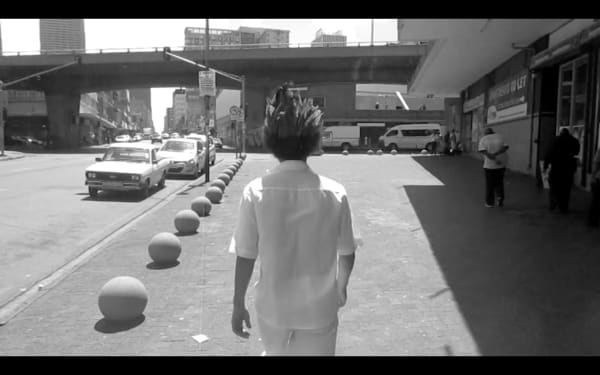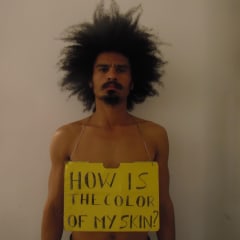TRECHERO Paulo Nazareth
Past exhibition
Overview
L'Arbre D'Oublier (Tree of Forgetfulness)
2013, video, 27'31
"During the slave trade from the African continent to America the men and women who were taken from their lands and arrived at the port of departure into an unknowing future - before crossing the Atlantic - had as their last alternative a ritual that had been taught by their ancestors: to revolve around the Oblivion Tree. The turns of these men and women would be responsible for the shattering of memory, erasing and canceling any relation with the memories and affectivities of the life before the kidnapping and traffic to the colonies. In the four presented videos - Ipê Amarelo | Cine Africa | Cine Brasil | L'Arbre D'Oublier - the artist walks these many laps. In choosing to turn back around the Oblivion Tree, Nazareth’s research somehow reconfigures the tragedy and return to the past, recalls that he was forced to forget.
Iroko do Bom Jesus
2017, video performance, 4'17
"In Barra do Guaicuí, Minas Gerais, Paulo Nazareth found the church Senhor Bom Jesus do Matosinho, with its externally taken almost entirely by the tree that represents Iroko in Candomblé. The artist climb by its roots, as interwoven with those icons, which is an essential practice in your body of work. While not ignoring the materiality of the Catholicism’s power and the marginalization of African religions and indigenous culture, the work proposes a reflection on the relationship of faith established by religious politics in the process of colonization and consequently in the formation of the Brazil that we live in today, being contradictory, multilateral and syncretic. But in addition, here is a record of the relationship between the personal experiences of Nazareth and what configured as sacred by him.
Porque galinha não chora?
2008 , video , 8'08
"The video accompanies the death of a chicken in a documentary site, from the choice of the animal by the it’s owner to the execution. Nazareth investigates the relations between countryman and the symbolism charged with the slaughter of the animal for the consumption and the intersections with the rituals of Afro-Brazilian religions considered profane when this action is established in the invisible platform of the faith.
Pé Vermei
2005, video performance, 7'46
"In Pé Vermei, the artist walks through the streets of Belo Horizonte with his feet painted in red, referring to the term used to name the rural man and his daily contact with the land - maintainer of his sustenance and food. In this way, Nazareth, while walking in the "city", insists on the affirmation of the body of the countryman in this urbanized space as an act of resistance of the simple man and the cities sprawl and the consequent erasure of possibilities imposed by this supposed progress.
2013, video, 27'31
"During the slave trade from the African continent to America the men and women who were taken from their lands and arrived at the port of departure into an unknowing future - before crossing the Atlantic - had as their last alternative a ritual that had been taught by their ancestors: to revolve around the Oblivion Tree. The turns of these men and women would be responsible for the shattering of memory, erasing and canceling any relation with the memories and affectivities of the life before the kidnapping and traffic to the colonies. In the four presented videos - Ipê Amarelo | Cine Africa | Cine Brasil | L'Arbre D'Oublier - the artist walks these many laps. In choosing to turn back around the Oblivion Tree, Nazareth’s research somehow reconfigures the tragedy and return to the past, recalls that he was forced to forget.
Iroko do Bom Jesus
2017, video performance, 4'17
"In Barra do Guaicuí, Minas Gerais, Paulo Nazareth found the church Senhor Bom Jesus do Matosinho, with its externally taken almost entirely by the tree that represents Iroko in Candomblé. The artist climb by its roots, as interwoven with those icons, which is an essential practice in your body of work. While not ignoring the materiality of the Catholicism’s power and the marginalization of African religions and indigenous culture, the work proposes a reflection on the relationship of faith established by religious politics in the process of colonization and consequently in the formation of the Brazil that we live in today, being contradictory, multilateral and syncretic. But in addition, here is a record of the relationship between the personal experiences of Nazareth and what configured as sacred by him.
Porque galinha não chora?
2008 , video , 8'08
"The video accompanies the death of a chicken in a documentary site, from the choice of the animal by the it’s owner to the execution. Nazareth investigates the relations between countryman and the symbolism charged with the slaughter of the animal for the consumption and the intersections with the rituals of Afro-Brazilian religions considered profane when this action is established in the invisible platform of the faith.
Pé Vermei
2005, video performance, 7'46
"In Pé Vermei, the artist walks through the streets of Belo Horizonte with his feet painted in red, referring to the term used to name the rural man and his daily contact with the land - maintainer of his sustenance and food. In this way, Nazareth, while walking in the "city", insists on the affirmation of the body of the countryman in this urbanized space as an act of resistance of the simple man and the cities sprawl and the consequent erasure of possibilities imposed by this supposed progress.
Works
Installation Views







